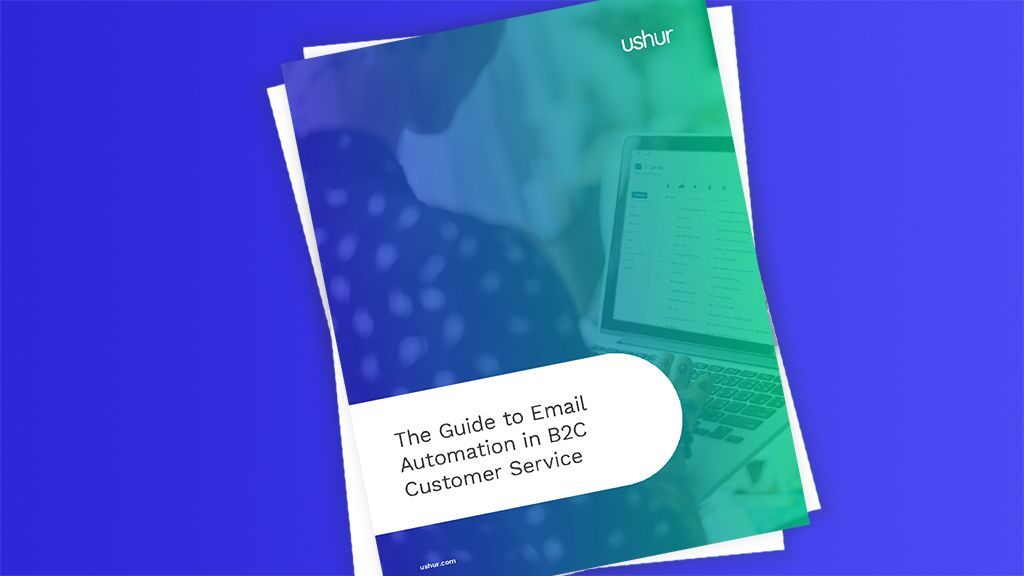
B2C enterprises everywhere are completely swamped with customer emails. Even the world’s most efficient support agent can’t wade through the torrent of customer emails pouring into bulk inboxes quickly enough to respond in a timely manner. All of these emails have to be reviewed and routed to the correct employee, who then must read the email again and finally write a reply. It’s no wonder agents everywhere are desperately wondering how to respond to emails faster.
That’s the focus of our latest e-book, The Email Automation Guide for B2C Customer Service.
The guide unpacks how email automation software (like Ushur’s SmartMail solution) processes thousands of incoming emails, attachments and photos to help you answer customer queries more efficiently.
In under a second, SmartMail categorizes bulk emails based on pre-set email classification rules, auto-responds to each sender and forwards the email to the appropriate internal team. If it’s a simple question, SmartMail’s conversational AI and intelligent processautomation services can retrieve information from back-end systems and proactively answer the customer. Pretty amazing, right?
Even sending them a holding message (“we’re working on your issue!”) via outbound email automation software is a big improvement in responding to customers faster. No, really! A little validation that they’re not being ignored goes a long way.

For one, responding to customer emails faster curbs channel switching. Channel switching is when customers cycle through multiple conversation platforms over the course of their journey. If a customer doesn’t get the help they need over email, they’ll keep trying other outlets (like your support line) until they reach you. The more delayed your response, the more likely you’ll trigger channel switching.
Channel switching quickly becomes detrimental because it runs up your OpEx astronomically. Live channels (phone calls, live chat, manual email) cost about $8.01 per contact, while self-service channels (automated email, chatbots, mobile apps, website FAQs) cost around only $0.10 per contact. Switching to even one live channel incurs an OpEx cost 80 to 100 times higher.
Self-service channels save
per contact
OpEx cost increases
without one live channel
Automated email sending, even if it’s simple holding messages, blows your customer’s expectations out of the water. Forrester research found that while 41% of customers expect an email response within six hours, only 36% of businesses respond that quickly and 14% never respond at all.
Related Content

How Email Automation Improves the Customer Service Experience
| Customer Service Problem | Email Automation Solution |
|---|---|
| Support inbox receives 100,000 emails a month | Inbound email processing AI scans, reviews, classifies and routes to the right department in seconds |
| Agents spend valuable time answering the same simple questions over and over | Pulls relevant answers from knowledge banks and back-end systems and auto-responds to the sender |
| The longer emails sit in the queue, the longer customers wait for responses, the most frustrated they become | Automated email routing helps questions get answered faster |
| Customer emails are often missing key information | Outbound email automation software proactively responds to the customer to request missing details |
| Manually extracting relevant data from emails and populating fields takes forever | Smart email workflow automation populates form fields, extracts data and connects with back-end systems |
Let’s look at a real email routing case study. A life insurance company serving 1.3 million customers sought to use an automated email system for the hundreds of thousands of emails it receives every year. Every email was opened and read by a member of the email-triage team, who would classify based on Key Business Indicators (KBIs) and forward it to the appropriate team. There the email would be opened and read again, and finally sent to an individual case manager.





Customers interacting with automated email platforms notice a difference. Questions actually get answered and problems are resolved delightfully quickly. They have validation the issue is being addressed—even if it’s just an auto-response that says “we’re working on it!” They’re no longer left wondering if their email was lost in the ether.
For enterprises always drowning in a flood of messages, email automation delivers the holy grail: inbox zero.
Customer support agents are limited by fatigue, the 40-hour work week and the increasing weight of unanswered emails on their motivation. AI reaches the end of the queue in seconds and looks around for more work. With your email bases covered, employees assigned to the menial review-and respond-work are freed to focus on more business-critical tasks.
Enterprises using email automation can not only achieve the impossible (processing hundreds of thousands of emails every month), they can eventually run a nearly hands-free operation, automating 100% of incoming email.
Applying conversational AI and machine learning transforms email from a major headache into a compelling channel that actually solves issues. Sure, automated data extraction and population knock out time-consuming, error-prone tasks, but they can also enable new business insights.
Data extraction tools pull critical information from customer emails. Data population tools automatically ingest it to your CRMs or systems of record (if your email automation platform integrates with back-end systems). That’s already a huge bridge to better understanding your customers. Email automation platforms with reporting dashboards take analytics a step further, delivering real-time stats on automation activity, customer engagement rates and step-by-step responses.
